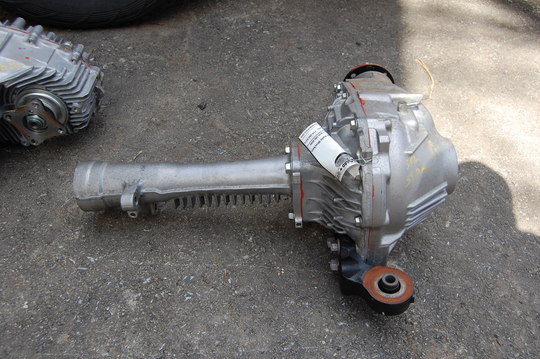bjowett
Supporting Vendor
The decision has been made to concoct  a front E-locker for the 200 Series Land Cruiser that is in the stable.
a front E-locker for the 200 Series Land Cruiser that is in the stable.
First the whys... Most of the parts to build it already exist. I like the factory e-locker design. It's fairly reliable, and if it does have issues, they can be dealt with trail side. Now I realize the 80 Series rear 1.31" 30 spline version of this locker has been known to twist the shaft and create a situation where the dog clutch can no longer slide, especially when used heavily with large tires. The front jackshaft on the 8.7" differential is a 34 spline 1.39" diameter unit. It's far beefier, and operates in a less abusive application.
How. The 200 is AWD, so the front differential is a clamshell IFS with jackshaft.

Now, the 2nd Gen Tundra is based on the LC, so it shares the front differential size and design. The major difference is that it has a part time system. Being part time, it uses the differential disconnect system to engage/disengage the 4x4. The actuator in this system works in an identical fashion to an e-locker, same motor drive, signals, and all. It mounts on the jackshaft housing, and normally connects/disconnects the right side axle shaft to engage/disengage the differential. The actuator is in the perfect place to use, for those familiar, a splined shaft and dog clutch to create an e-locker.
Housing comparison.

Tundra jackshaft housing on LC diff w/ LC jackshaft. The LC jackshaft maintains an OD of 1.393" for the entire length. This will allow the shaft to have the 34 splines cut further down the length of the shaft, thus giving the dog clutch an appropriate splined area to ride on.

Jackshaft showing actuator fork location. The shaft will be splines here.

This picture shows the dog clutch. It slides right into the diff housing and will engage the differential body, locking the shaft to it, and creating a locker. This is a 1.31 FZJ80 unit, plenty of material to have it made in a 1.39" 34 spline piece.

Now the the tougher part of this. Teeth for the dog clutch to engage need to be created. I may try to find a way to add them to the existing differential, or machine a whole new differential unit. Thoughts and ideas on this are welcome.
First the whys... Most of the parts to build it already exist. I like the factory e-locker design. It's fairly reliable, and if it does have issues, they can be dealt with trail side. Now I realize the 80 Series rear 1.31" 30 spline version of this locker has been known to twist the shaft and create a situation where the dog clutch can no longer slide, especially when used heavily with large tires. The front jackshaft on the 8.7" differential is a 34 spline 1.39" diameter unit. It's far beefier, and operates in a less abusive application.
How. The 200 is AWD, so the front differential is a clamshell IFS with jackshaft.

Now, the 2nd Gen Tundra is based on the LC, so it shares the front differential size and design. The major difference is that it has a part time system. Being part time, it uses the differential disconnect system to engage/disengage the 4x4. The actuator in this system works in an identical fashion to an e-locker, same motor drive, signals, and all. It mounts on the jackshaft housing, and normally connects/disconnects the right side axle shaft to engage/disengage the differential. The actuator is in the perfect place to use, for those familiar, a splined shaft and dog clutch to create an e-locker.
Housing comparison.

Tundra jackshaft housing on LC diff w/ LC jackshaft. The LC jackshaft maintains an OD of 1.393" for the entire length. This will allow the shaft to have the 34 splines cut further down the length of the shaft, thus giving the dog clutch an appropriate splined area to ride on.

Jackshaft showing actuator fork location. The shaft will be splines here.

This picture shows the dog clutch. It slides right into the diff housing and will engage the differential body, locking the shaft to it, and creating a locker. This is a 1.31 FZJ80 unit, plenty of material to have it made in a 1.39" 34 spline piece.

Now the the tougher part of this. Teeth for the dog clutch to engage need to be created. I may try to find a way to add them to the existing differential, or machine a whole new differential unit. Thoughts and ideas on this are welcome.

